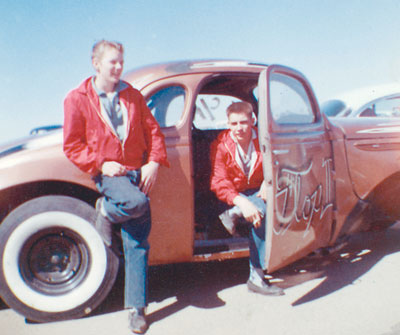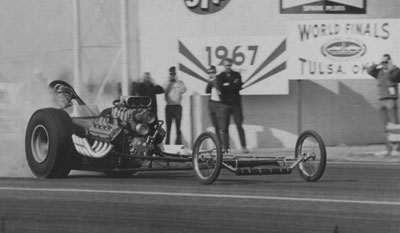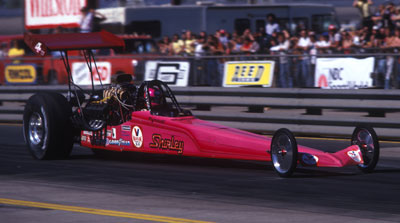

Crowning champions, then and now
I had planned today to share – as promised Tuesday -- some stories behind the stories of former NHRA Funny Car world champ Phil Castronovo, who passed away Saturday, but, without boring you with details, one thing led to another, and I’m now instead going to present it Tuesday. I’ve spoken briefly to his brother Fred to offer my condolences and to request an interview, which I hope to do later today, and have heard from Phil and Fred’s nephew (also named Fred and the son of their brother Victor) and reached out to Tom Prock, who took over the wheel of the Custom Body Enterprises car from Phil in 1972. When all of the pieces do come together, it should be an entertaining tale, so instead, today I’ll talk about the somewhat controversial way in which champions, including Castronovo, were crowned in the 1960s and 1970s.
Today, the Countdown to the Championship has its fans and its detractors. The fans rave about the close battles and high drama it creates at the end of each season, and its detractors complain that it penalizes racers who kicked butt for three-fourths of the year only to have to relinquish their points leads, but it's all part of a long history of changes to the process for crowning our Professional champions (and even our Sportsman titlists) that has evolved numerous times throughout the years.
Although national events as we know them today began in 1955 and each of the Top Eliminator winners at the first Nationals was, in some way, a de facto national champion for beating all comers at the year’s biggest race, it wasn’t until 1960 that NHRA crowned its first official world champion, Buddy Garner. A lot of people think that NHRA didn’t crown its first points-based champion until 1974 because, for a period from 1965 through 1973, the winners of the annual World Finals were crowned the season champs. And though that’s true, as you will see, it was a points-based system that earned them the right to race at the Finals, and it was a points-based championship that crowned Garner as NHRA’s first world champ.
NHRA implemented its new championship points program in 1960 aimed at determining a national points champion "in an effort to add more interest for those active in drag racing, regardless of their competition class or geographical location." In many ways, it’s similar to how today’s Sportsman champs are crowned in that it allowed racers to accumulate points locally instead of traveling across the country.
 Buddy Garner, NHRA's first world champion (1960) |
To ensure that no region was able to benefit from favorable climatic conditions that would allow its racers to run more events, the points-earning season ran 26 weeks, from April 3 until Sept. 25. Points were awarded at all NHRA-sanctioned dragstrips, with 10 points awarded to the winner in each class at weekly events and 10 additional points going to the winners of the overall Top, Middle, Little and Stock eliminators for each meet. Winners of NHRA regional and divisional meets received 20 points for a class win and 20 points for Top, Middle Little and Stock eliminator wins. Winners at the NHRA Nationals, held again that year in Detroit, received 50 points for a class win and 50 points for Top, Middle, and Little eliminator wins.
Garner, of Hobbs, N.M., drove his Chevy-powered C/Altered Plymouth to 24 of a possible 26 class wins during the 26-week season and accumulated 500 points, 10 more than Earl Rowe and his Richmond, Va.-based S/SA Pontiac. Jack Chrisman won the championship in 1961, scoring 550 points with his nearly unbeatable AA/D, and Jess Van Deventer with his small-block Chevy B/MR was crowned the 1962 champ. In 1963, NHRA decided it was time to expand the championship program to two divisions – Hot Car and Stock Car – which were won, respectively, by Charlie Smith and Ronnie Broadhead.
 Jack Williams, NHRA's first Top Fuel world champ (1964) |
In 1964, NHRA planted the seed for today's individual-class points-based championships with the introduction of the Jackpot Circuit. Built around a 50-event season, racers in six categories (Top Fuel, Top Gas, Competition, Street, Stock, and Little Stock) could count nine events toward their totals. The late Jack Williams became NHRA's first Top Fuel season champion after a dominating year. Texan Roy Davis, a relative unknown, captured the Top Gas championship, and California-based Ford Thunderbolt pilot Gas Ronda outlasted huge fields of Dodges and Plymouths to earn the Top Stock Eliminator title. Smith, the 1963 world points champion, was crowned the king of Comp after wheeling his Plain Vanilla A/Altered past all challengers, including his toughest foe, brother Frank. Street Eliminator and Junior Stock championships went to Californians Bill Hoefer and Mike Schmitt, respectively.
The Jackpot system lasted just one year. In 1965, when NHRA added the World Finals in Tulsa, Okla. (and the Bristol-based Springnationals) to the schedule, it became the championship decider. Racers qualified to compete at the event based on points accrued at six events in each of NHRA's divisions, with each division's top two finishers allowed to attend the event. Maynard Rupp, who had beaten Danny Ongais in the semifinals, won the Top Fuel crown on a solo pass when "Rapid Red" Lang broke on his semifinal single and was unable to answer the final-round bell. Other 1965 world champions were Jim Minnick (Top Gas), Joe Smith (Top Stock), Virgil Cates (Comp), Gene Moody (Street), and Doug Kahl (Jr. Stock).
 Benny Osborn, NHRA's first two-time Top Fuel world champ (1967-68) |
The setup remained intact, though it was modified somewhat throughout the years. In 1967, for example, the 16-car fields for the Finals were composed of the seven division champs, who were seeded into the field, and the nine remaining spots were open for qualifying among the 28 drivers who became eligible to compete at the event by finishing in the top five in their division. Benny “the Wizard” Osborn won the Top Fuel title that year and would win it again in 1968, becoming NHRA’s first two-time Top Fuel champ.
Ronnie Martin, Top Fuel champ of NHRA’s 1970 “Super Season,” created a bit of a rogue wave as he won the season crown in Robert Anderson's Louisiana-based entry with the only Top Fuel win of his career, a feat duplicated by “one-hit wonders” Gerry Glenn in 1971 and Jim Walther in 1972. It was the same story in Funny Car, when Castronovo (1971), Larry Fullerton (1972), and Frank Hall (1973) won the Funny Car crowns in the only NHRA national event winner’s circle appearances of their careers, though all, obviously, enjoyed a degree of success on the divisional level. (I’ve addressed the whole “one-hit wonder” thing in previous columns here and here and mean no disrespect by the use of the term because national event success alone should never be the summation of anyone’s career.)
Joining Hall as Pro champs in 1973 were Jerry Ruth in Top Fuel and Wayne Gapp in Pro Stock, who would go on to win more national events -- two and five, respectively -- but nonetheless (and interestingly) claimed the championships with their first national event victories.
Although Sportsman champions through 1980 were still crowned on the basis of victories at the World Finals, the 1974 season was the first in which Pro champions were crowned based solely on points accumulated throughout the season, but for the next decade, the totals still were not decided solely at the national level as divisional-race attendance also was required (in 1975, for example, a minimum of two, a maximum of five). From there, it got a little wacky.
 Shirley Muldowney, NHRA's second two-time Top Fuel champ (1977 and 1980) and its first three-time fuel dragster titlist (1982) |
By 1978, racers could only earn points at seven of the nine national events on the calendar (plus five divisional races), and drivers were allowed to waive their points for an event at any time prior to the start of final eliminations. In 1979-81, racers could choose to either earn points at all 10 national events, at nine national events and two divisional meets (which offered easier competition but only half the points), at eight national events and four divisional races, or seven national events and six divisional races. This probably had as much to do with continuing to support the divisional series as it did taking a bit of a financial traveling burden off of some teams.
In 1982-84, racers could choose only between counting points at any 10 of 12 national events on the schedule or at nine events (one of which had to be the World Finals) and the two half-points “pro bonus” events, the Popular Hot Rodding Championships at U.S. 131 Dragway in Martin, Mich., and the Super Stock Nationals at Maple Grove Raceway. The 1985 season was the first to produce Pro world champs based solely on their national event scores at all events on the schedule.
(NHRA’s method for crowning Sportsman champs has continued to evolve to the point where today a familiarity with mathematics is almost as essential as wheelwork. In 2011, Top Alcohol Dragster and Top Alcohol Funny Car championships are based on points totals from 10 races -- five national and five divisional -- earned at a maximum of eight national and eight divisional events. The other NHRA Lucas Oil Drag Racing Series titles are based on points earned at eight races -- three national and five divisional -- earned at eight divisional and six national events. (Basically, it’s still a waiver-like situation, but one in which worst races are automatically tossed out once they are bettered within the allotted totals.)
Some would argue that the Professional champions between 1965 and 1973 didn’t do as much to earn their titles as those who followed, that their titles were not decided in frequent head-to-head competition with their toughest peers from other parts of the country as is common today, and I think that’s why people sometimes forget that guys like Martin, Glenn, Walther, Castronovo, Fullerton, and Hall were crowned NHRA world champs.
Which is where we come in. We won’t forget. Ever.



















































